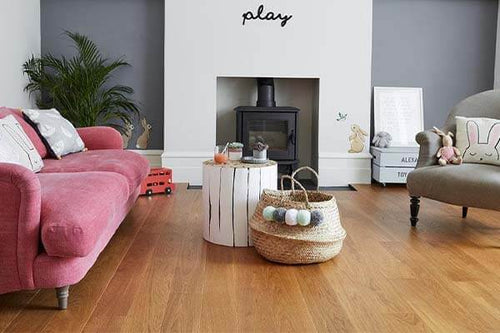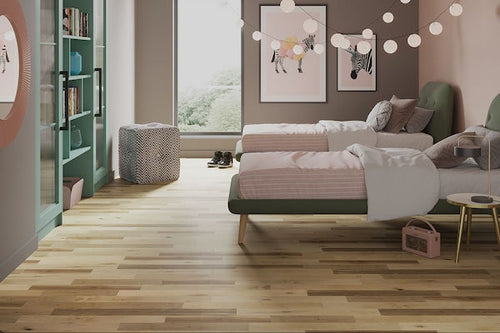With the appearance of solid wood but easier to install, engineered wood has become a popular choice for many homes. Giving the same irresistible feel and an unmistakable natural look, engineered wood is a great choice throughout most areas of the home.


How durable are wood floors?
Because it's made in layers, engineered wood flooring has good stability, which means it's not as prone to shrinking or warping, as much as solid wood is. This stability makes it possible to use click systems at the joints so it's ideal for anyone looking for a real wood floor they can install themselves.
Providing you follow our How to Install Engineered Wood Flooring guide, it really is simple to fit. However, click system floors are only really designed to ‘float' on top of an existing subfloor. If you're looking to install your floor directly onto joists, then some of our engineered wood floors come with a traditional tongue and groove joint for this very reason.
Engineered wood comes in either a multi-ply or three-ply construction. Multi-ply floors feature a core made up of several layers of plywood for a floor with superior strength and stability and so this construction finds its way on to higher quality flooring. By using a softwood or HDF ‘core' layer, it is possible to still offer strength and stability but at a lower price.
As a natural product, engineered wood flooring needs to become used to the conditions of your home before it is installed. This is called the Acclimatisation Period. Even though more stable than solid wood flooring, engineered wood floors will still move slightly, so it's best to let your engineered wood floor ‘settle' into its new environment before you install it. We recommended a minimum of two days between receiving your floor and installing it.


How to install engineered wood flooring
With a machined profile, click systems make it easy to join each board to the next. Each ‘male' joint is angled into the ‘female' joint of the opposing board (fig: 1). Downward pressure is applied to lock the boards in place and form a secure and reliable joint (fig: 2). The system makes installation fast and easy and completely removes the need for gluing or screwing the boards together. This makes it a favourite for people looking for a floor they can install themselves.


The look of engineered wood flooring
The look of engineered wood flooring depends on four main aspects; the species of wood, the grade of the grain, surface finish and the size of the plank.
The grade of the hardwood layer is not an assessment of quality, but of how your floor will look. Here at UK Flooring Direct, our three different grades are: ‘Rustic', ‘Nature' and ‘Select.' Rustic embraces the wood's natural swirling grain patterns and colour variations, Nature provides a traditional looking finish, with less knots or mineral streaks than Rustic, whilst Select has the least amount of variation and only a few pin hole knots for a clean look.


Made from natural wood, every plank has a unique character and charm. A brushed surface finish will raise the texture and markings of the grain, giving the floor a more natural and organic quality. A floor that has been sanded smooth has less tangible texture and is a popular choice in contemporary style interiors. As your engineered flooring has a durable wear layer, this allows you to extend your floor's lifespan as you can then sand and re-finish your floor in many years to come - a true investment.
How to maintain engineered wood flooring
Engineered wood flooring makes a great investment and while most floors from UK Flooring Direct will last for decades if cared for and looked after properly. The hardwood top layer and finish applied to it is the key in choosing an engineered wood floor that fits in with your lifestyle and your expectations.


The overall thickness of the floor has little to do with how it will stand up to well wear or how long it will last, this is the job of the hardwood top layer. Most engineered wood floors can be sanded at least once or twice, giving a long life that is enough for most families, but for the very best life, floors with a top layer of 6mm or more can last for a lifetime in most domestic situations.
The finish of your engineered wood floor will affect how to look after it day-to-day and how much care you will need to give it to keep it looking its best.
Our floors are available in a lacquered or oiled finish. A lacquered finish is applied to the surface in several layers on the hardwood top layer to form a protective ‘barrier'. Easier to look after than oil finishes, lacquered floors can be used in busy areas such as kitchens and dining rooms as they are more resistant to spills and marks. However, once worn, a lacquer finish will need to be sanded off and reapplied. Our premium lacquers are exceptionally tough, so this will not be for several years in most homes.
If you want an organic look to your floor than oil finishes offer the most natural look. Several layers of oil are applied in the finishing process, absorbing into the wood to give some protection. The oil allows the original texture and feel of the wood to remain though will require periodic intensive maintenance with a top-up oil to prevent the wood drying out. Oil finishes show signs of wear in areas used the most, so develop a wonderful ‘lived in' feel that is unique to your home. However, they are more susceptible to marks and spills so are not recommended for use in kitchens.
Where to use engineered wood flooring
Hard wearing engineered wood flooring can be used in most areas of the home including dining and living rooms, hallways, kitchens and bedrooms. However, it's important to remember that it's still a natural product, so we do not recommend engineered wood flooring in bathrooms or any other high moisture environment where there is a potential for leaks such as utility rooms. If you are choosing your floor for the kitchen or hallway, we recommend lacquered wood flooring as it is easier to maintain and is better at resisting spills and marks than an oiled wood flooring.
If your home has water or electric under floor heating, then engineered wood is completely safe and suitable for use as its stable enough to withstand temperatures of up to 27 degrees. However, when turning on the underfloor heating for the first time, or after a prolong period of being turned off, increase the temperature gradually over a period of days so that the floor can acclimatise to the change.


Engineered wood flooring is suitable for the following rooms: kitchens, living rooms, dining rooms, hallways, bedrooms and conservatories.
Need some help?
That should be everything you need to know about engineered wood flooring from UK Flooring Direct. If you’d like to learn more about our story and what makes us unique, check out our blog: 20 Things You Didn't Know About UK Flooring Direct.
If you have any more questions, you can call one of our Flooring Experts on 02476 012 840, who will be happy to help you on the journey to finding your perfect floor.


